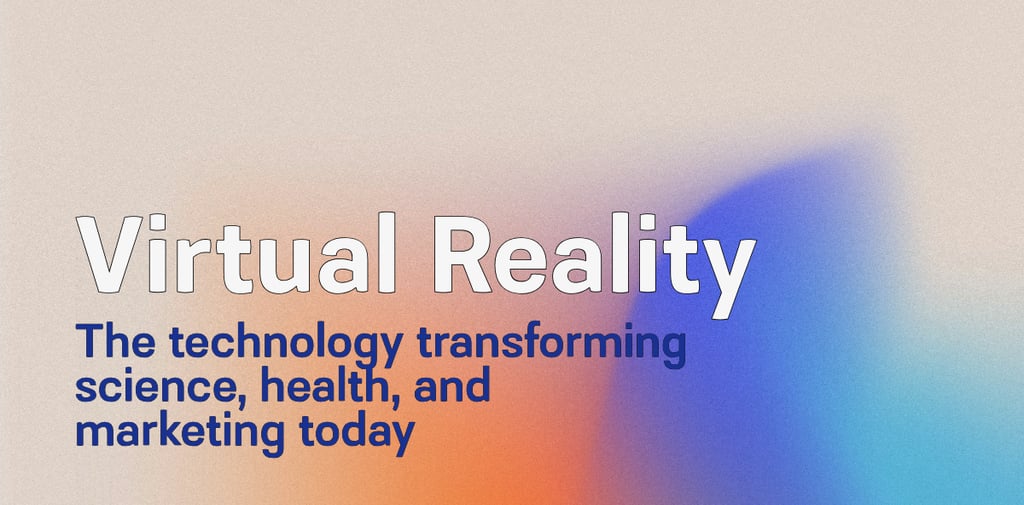Virtual Reality: A Technology Transforming Science, Healthcare, and Marketing
Michell Vivas
7/1/20253 min read


Virtual reality has moved beyond fantasy to become a key tool in medicine, science, workforce training, and marketing.
Its applications are so broad and its evolution so fast that defining it can be tricky. One might say it helps reduce pain in pediatric patients or ease pre-surgery anxiety (as reported by Mayo Clinic); that it improves hands-on training for workers in dangerous jobs by simulating reality without real-world risks (per the UN); that it helps NASA astronauts prepare for lunar missions more realistically; that it offers hyperrealistic simulations for public speakers to overcome stage fright (according to the University of Cambridge); or that it streamlines onboarding in multinational companies through virtual reality-based evaluations (as announced by Forbes just two months ago).
But what exactly is this tool with so many benefits across virtually every area of life and the economy?
According to the Royal Spanish Academy, virtual reality is simply:
"The representation of scenes or images of objects produced by a computer system, giving the sensation of real existence."
A basic definition, yet one that barely scratches the surface of the growing advantages and possibilities it offers.
We no longer need to imagine The Matrix or spend hours in a video game simulator to experience a semi-believable virtual reality. Today, this technology enables total immersion in digital environments, thanks to specialized devices. It provides visual and auditory input, while complementary technologies map the user’s movements into the virtual space, creating a deeply immersive experience.
With just a single photo or prompt, anyone can explore any imaginable place. But beyond fantasy, virtual reality is driving scientific breakthroughs, improving clinical and workplace practices, enabling pre-travel experiences, increasing testing accuracy, and facilitating entirely new forms of interaction.
Virtual Reality and Marketing
In this context, virtual reality has also entered the world of marketing, opening unprecedented opportunities for emotional, personalized, and immersive brand connections.
1. Virtual Events and Trade Shows
VR events have revolutionized product launches, trade fairs, and business conferences. Attendees can visit digital booths, speak in real time with brand reps, join talks, and network—all from anywhere in the world.
2. Virtual Product & Service Demos
Brands can offer customers the chance to test products/services in virtual environments before purchasing. This enhances the user experience, reduces returns, and increases satisfaction—from trying on clothes to simulating furniture in a real space.
3. Immersive Storytelling
Virtual reality enables brands to tell stories like never before. With 360° content, users are placed inside the brand narrative, deepening emotional connection and transforming them from observers into protagonists.
4. Virtual Tours
Consumers can explore physical spaces without leaving home. Hotels, real estate, and travel destinations use VR to build trust, accelerate decisions, and offer realistic previews of what customers can expect.
Why VR is a Marketing Advantage
Integrating VR into digital strategies—especially event marketing—offers key benefits:
Builds deeper emotional engagement
Creates memorable, immersive experiences
Enhances brand recall and loyalty
Plus, virtual events:
Remove geographic barriers
Enable global participation
Lower logistics costs
Provide real-time data on user interaction for better strategy optimization
In short, VR strengthens brand storytelling, product showcasing, and customer interaction—turning every event into a dynamic, personalized experience.
From VR to Intelligent Marketing: Automatia Bot
As technology advances, now more than ever is the time to embrace solutions that combine intelligence, automation, and results.
Automatia Bot, now Meta-certified as a tech provider, offers exactly that: tools to optimize ad campaigns, generate more leads, reduce manual processes, and save valuable time so brands can focus on what really matters.
It’s not just about automation, it’s about evolving how brands communicate, sell, and grow in increasingly complex digital environments like virtual reality.
In fact, some studies report that up to 39% of patients express higher satisfaction when VR is integrated into healthcare systems, a powerful indicator of how well-applied technology transforms user experiences.
Sources
What is Virtual Reality? | Adobe
Virtual Reality: Benefits & Drawbacks | Business School Barcelona
How Augmented Reality is Reshaping Marketing | Mailchimp
Virtual Reality in Advertising | ESIC University, 2024
Contact us
© 2025. All rights reserved. Made with Love by stealthstartup0
